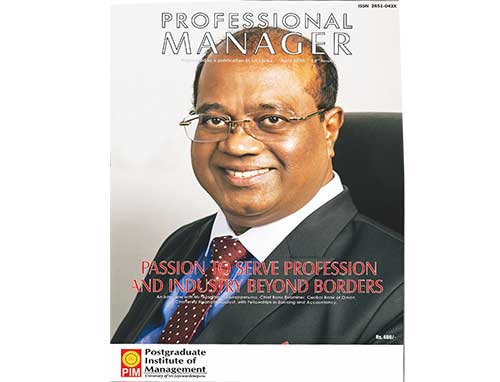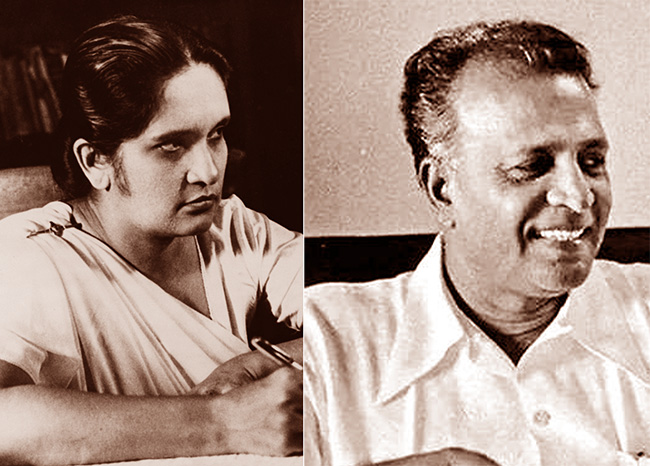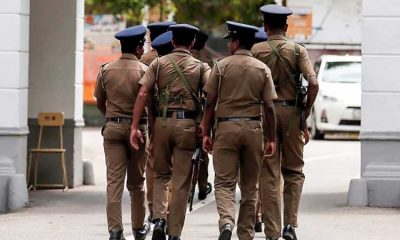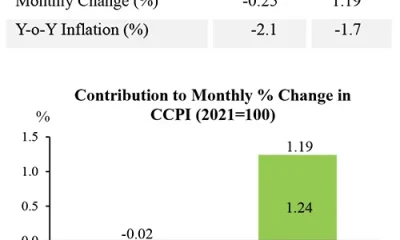Sat Mag
PROFESSIONAL MANAGER

Reviewed by
K. A. I. Kalyanaratne
Consultant – Publications
Postgraduate Institute of Management
University of Sri Jayewardenepura
By-annual publication of the PIM : Issue No. 18
There are mainly four ways of acquiring knowledge on management, and for that matter on any discipline. They are through Research, Text books, Seminars and Workshops, and Periodic publications (journals / magazines). Each of these has its inherent advantages and limitations. Research works, once published and presented, take a long time either to come as simplified versions or get accommodated in subject-based text books. Text books have time-gaps as they take longer periods to revise and update their contents. Further, most of these updates are dependent on relevant research works, and best practices evolved through trial and error and acceptance. Seminars and workshops, although serve a useful purpose, their infrequent conduct, limited participation and inadequate documentation would, more often, impose limitations on their impact on the relevant segments.
Against this backdrop, periodicals have been accepted as serving the desired sectors better, especially the professionals, who devote more time on their jobs, than perusing /reading research findings, text books and/or attending seminars and workshops. However, the fact remains that these periodicals need to be regular, frequent and focused, if they are to serve a useful purpose. In the context of the discipline of management, such periodicals should not be mere vehicles for carrying conceptual knowledge. Management, being an operational discipline, what matters most is practicality and proven utility of the practices.
Thus, the Professional Manager, the regular management publication of the Postgraduate Institute of Management (PIM), which has served our professional managers for the last twelve (12) years, has now published its latest issue – Issue No. 18, equipped with a rich array of articles that will further enrich their managerial acumen. As usual, its cover page features an alumnus of the PIM, Mr. Ajantha Madurapperuma, who currently holds a strategic position as Chief Bank Examiner at the Central Bank of Oman. The feature article, presented in the form of an interview, under the caption “Passion to Serve Profession and Industry beyond Borders,” spells out his experiences in serving as a professional in an overseas market, away from home. With his indepth experience as a banker-cum-teacher, referring to performance excellence, he professes that: “There is no time to stop or take a break in professional competence development. Regardless of the level of seniority in career, one must spend time learning, unlearning and relearning.”
An article that would, for certain, gain much currency, especially among the powers that be, is the analytical observations on the most critical issue nations are currently confronted with, namely, the COVID-19 pandemic. Dr. W.A.Wijewardena, (former Deputy Governor, Central Bank), being a veteran banker and a professional of repute, currently serving as a member of Boards of Studies of many academic and professional institutions, professes in his essay on “Sri Lankan Economy in Post-Covid-19 Era: A Black Sworn Perspective” that “At the global level nations have to cooperate and collaborate with each other rather than seek to win the game, individually. Individual country efforts can take a nation forward to a certain level. But that level is not enough for it to even restore what it had been earlier, let alone making an improvement.” In fact, Dr. Wijewardena’s critique provides an abundance of food for thought for our leaders as to how the country should be re-directed towards a ‘New Economic Model” in the aftermath of the pandemic.
Prof. Ajantha S. Dharmasiri, Director, PIM, provides under the catchy caption “Legendary Wealth of “Well Done”: Treasures of a Transformational Leader” an insightful account of Jack Welch, legendary leader, former chairman and CEO of General Electric. It’s an article that projects the managerial acumen of Jack Welch from many angles, and shows what Sri Lankan business leaders, and administrators, could elicit from Welch’s doings as well as his goods and bads. Through his profound insight, Welch propounded that “I’ve learned that mistakes can be as good a teacher as success”. A most thought-provoking quote of Welch as mentioned in the article is “We want each man and woman in this company to see a connection between what he or she does all day and winning in the marketplace”. This provides much food for thought for all managers, as what we have been insisting on has been to cling to our job-description, sans an iota of an idea as to how our jobs would impact the overall objectives of the organization. A job, to be meaningful, its doer should know not only ‘what and how’ but also a job’s ‘why’ aspect. A job needs to have relevance to the stakeholders. The brevity of the article would, surely, provide an impetus to make it ‘a must to read’.
The Postgraduate Graduate Institute is at a tremendous advantage in publishing the Professional Manager, as most of its article-contributors are those who have taken to teaching, having had much exposure in their spheres of specialty. Dr. Trevor Mendis who writes on “Banks Drowning Under Non-performing Advances : Reasons to Reflect” is in possession of a repertoire of banking experience. Therefore, its contents are first-hand knowledge, coming from a horse’s mouth. Through his profundity he says that “Corporate Governance explains that directors (of a company) should be a set of professionals with business acumen, knowledge and competencies in their given fields.”
The lineup of the rest of the articles is:
Inside-out vs. Outside-in: Doing Business Differently
The inside–out approach is guided by the belief that inner strengths and capabilities of the organization will make the institution prevail, while the outside-in approach is directed by the belief that customer value creation, customer orientation and customer experiences are the keys to a firm’s success.
Contemporary Manufacturing Practices for Sustainable Supply Chain
Stresses the importance of harmonizing best practices with manufacturing strategy, and emphasizes that supply chains need to respond quickly to shifting market needs and competitive dynamics in the environment while keeping their operational costs at a minimum level.
Our Chit-chat: Can Conversations Make a Nation?
The writer says that a meeting degenerating into just verbal exchanges or carried out in a lackluster manner only to suit the nominal agenda is unlikely to result in any rich exchange of ideas, and overall elevation of knowledge.
Creating a Collaborative Culture: Engaging with 5S and Mindfulness
Organizational culture percolates through every layer of the organization, and influences every aspect of the organization. Taking a cue from the PIM, the writer explains how 5S and Mindfulness have helped the Institution create and promote a collaborative culture. A mutually collaborative approach promotes a system-driven, methodical, creative, disciplined and a conscientious set of employees.
Create or Cremate: Insights for Idea Generation
It’s a must for any organization to be creative for long-term sustainability. Discussing the major tools for promoting creativity, the writer discusses the implications for managers, and sheds sufficient light on the ways and means of creating the desired environment for creativity to spring up. He emphasizes that amidst all other approaches, generating high trust is of paramount importance in this context.
Industrial Engineering as a Utility-driven Discipline: Emerging Prospects
This is an article that highlights a lacuna that exists in our curricula, making a special plea for the introduction of Industrial Engineering, as it’s a utility-driven discipline. The writer proposes that the article may be considered more as a precursor towards future recognition, especially considering its hybrid nature and future prospects.
Money is Not an Evil If One Spends it Wisely
Basing on the Buddhist teachings, the writer succinctly compares and defines money and wealth, and concludes that as per the teachings of the Great Sage wealth is temporary and no path to happiness. The article further discusses some Buddhist teachings on how to collect real wealth in order to spend a wealthy life, and the ways of spending that wealth for maintaining a happy lifestyle.
Vision of a Medical Manager: Building High Quality of Care into Health Systems
The writer, being a medical practitioner, he analyses quality based on quality-dimensions as seen in the health sector. He concludes the essay by saying that “despite the resource constraints high quality of care can be embedded into the health system by ensuring sustainable leadership, and creating a conducive culture at every healthcare organization.
The Challenge of Managing the Foreign Debt: Sri Lankan Government’s Response
A very senior faculty member, specializing in Economics and Strategic Management, minutely analyses what ails our economy and the ways in which the country could overcome the current foreign debt issue. In the concluding remarks, he says that “The challenge is formidable for a country which has had weak and indecisive governments, a private sector which is not known either for its innovativeness or for a strong action orientation, and a population that is deeply immersed in ‘an entitlement culture’”.
Whither Sri Lanka? A PESTEEL Perspective
Analyzing the country’s current plight and applying the PESTEEL framework/tool used by marketers to monitor the macro-environmental factors, the writer, a specialist on economy and strategy, concludes her write-up with the following remarks, ‘A lack of accountability and visionary responsibility seem to have created an ambiance of a “live for the day” mentality’.
A GPS Guide for Correct Communication
The writer, a specialist in business communication, applies the GPS acronym as a guide for correct communication. According to the new interpretation of GPS, G stands for Grammar and Gesture; P stands for Pronunciation and Punctuation while S stands for Spelling, Seasoning and Selection. This acronym, in fact, provides a clear basis for learners in practising communication.
A Window of Global Learning Opportunities: A Glimpse of PIM International Management Programmes
This article, deviating from the normal subject-based analyses and interpretations, provides a window as to what the PIM has been doing in the organization and execution of international programmes. The PIM through this endeavour provides a wide choice and opportunities especially for senior members in public sector organizations to see-study-compare-adopt and excel by replacing the inclusive learning-teaching approach /approaches of yesteryear.
AMDISA, PIM & 15th South Asian Management Forum
The Professional Manager also provides presentations made by the PIM Faculty and the Senior Assistant Registrar at the 15th South Asian Forum (SAMF), organized under the aegis of the AMDISA (Association of Management Development Institutions in South Asia.
The PIM’s mission in publishing the Professional Manager would seem very close to what Peter F. Drucker said about the importance of identifying and exploiting the changes appropriately by the executives. What Management is, in short, is the wise use of means to accomplish the objectives.
“The most important work of the executives is to identify the changes that have already happened. The important challenge in society, economics, politics, is to exploit the changes that have already occurred and to use them as opportunities.”
Peter F. Drucker, The Age of Discontinuity
All in all, the latest issue of the Professional Manager (Issue 18) brings latest knowledge on an array of useful management inputs that will be handy material for professional managers wishing to elevate themselves and their organizations through improvements in knowledge, skill, habits, and attitudes.
Sat Mag
October 13 at the Women’s T20 World Cup: Injury concerns for Australia ahead of blockbuster game vs India

Australia vs India
Sharjah, 6pm local time
Australia have major injury concerns heading into the crucial clash. Just four balls into the match against Pakistan, Tayla Vlaeminck was out with a right shoulder dislocation. To make things worse, captain Alyssa Healy suffered an acute right foot injury while batting on 37 as she hobbled off the field with Australia needing 14 runs to win. Both players went for scans on Saturday.
India captain Harmanpreet Kaur who had hurt her neck in the match against Pakistan, turned up with a pain-relief patch on the right side of her neck during the Sri Lanka match. She also didn’t take the field during the chase. Fast bowler Pooja Vastrakar bowled full-tilt before the Sri Lanka game but didn’t play.
India will want a big win against Australia. If they win by more than 61 runs, they will move ahead of Australia, thereby automatically qualifying for the semi-final. In a case where India win by fewer than 60 runs, they will hope New Zealand win by a very small margin against Pakistan on Monday. For instance, if India make 150 against Australia and win by exactly 10 runs, New Zealand need to beat Pakistan by 28 runs defending 150 to go ahead of India’s NRR. If India lose to Australia by more than 17 runs while chasing a target of 151, then New Zealand’s NRR will be ahead of India, even if Pakistan beat New Zealand by just 1 run while defending 150.
Overall, India have won just eight out of 34 T20Is they’ve played against Australia. Two of those wins came in the group-stage games of previous T20 World Cups, in 2018 and 2020.
Australia squad:
Alyssa Healy (capt & wk), Darcie Brown, Ashleigh Gardner, Kim Garth, Grace Harris, Alana King, Phoebe Litchfield, Tahlia McGrath, Sophie Molineux, Beth Mooney, Ellyse Perry, Megan Schutt, Annabel Sutherland, Tayla Vlaeminck, Georgia Wareham
India squad:
Harmanpreet Kaur (capt), Smriti Mandhana (vice-capt), Yastika Bhatia (wk), Shafali Verma, Deepti Sharma, Jemimah Rodrigues, Richa Ghosh (wk), Pooja Vastrakar, Arundhati Reddy, Renuka Singh, D Hemalatha, Asha Sobhana, Radha Yadav, Shreyanka Patil, S Sajana
Tournament form guide:
Australia have three wins in three matches and are coming into this contest having comprehensively beaten Pakistan. With that win, they also all but sealed a semi-final spot thanks to their net run rate of 2.786. India have two wins in three games. In their previous match, they posted the highest total of the tournament so far – 172 for 3 and in return bundled Sri Lanka out for 90 to post their biggest win by runs at the T20 World Cup.
Players to watch:
Two of their best batters finding their form bodes well for India heading into the big game. Harmanpreet and Mandhana’s collaborative effort against Pakistan boosted India’s NRR with the semi-final race heating up. Mandhana, after a cautious start to her innings, changed gears and took on Sri Lanka’s spinners to make 50 off 38 balls. Harmanpreet, continuing from where she’d left against Pakistan, played a classic, hitting eight fours and a six on her way to a 27-ball 52. It was just what India needed to reinvigorate their T20 World Cup campaign.
[Cricinfo]
Sat Mag
Living building challenge

By Eng. Thushara Dissanayake
The primitive man lived in caves to get shelter from the weather. With the progression of human civilization, people wanted more sophisticated buildings to fulfill many other needs and were able to accomplish them with the help of advanced technologies. Security, privacy, storage, and living with comfort are the common requirements people expect today from residential buildings. In addition, different types of buildings are designed and constructed as public, commercial, industrial, and even cultural or religious with many advanced features and facilities to suit different requirements.
We are facing many environmental challenges today. The most severe of those is global warming which results in many negative impacts, like floods, droughts, strong winds, heatwaves, and sea level rise due to the melting of glaciers. We are experiencing many of those in addition to some local issues like environmental pollution. According to estimates buildings account for nearly 40% of all greenhouse gas emissions. In light of these issues, we have two options; we change or wait till the change comes to us. Waiting till the change come to us means that we do not care about our environment and as a result we would have to face disastrous consequences. Then how can we change in terms of building construction?
Before the green concept and green building practices come into play majority of buildings in Sri Lanka were designed and constructed just focusing on their intended functional requirements. Hence, it was much likely that the whole process of design, construction, and operation could have gone against nature unless done following specific regulations that would minimize negative environmental effects.
We can no longer proceed with the way we design our buildings which consumes a huge amount of material and non-renewable energy. We are very concerned about the food we eat and the things we consume. But we are not worrying about what is a building made of. If buildings are to become a part of our environment we have to design, build and operate them based on the same principles that govern the natural world. Eventually, it is not about the existence of the buildings, it is about us. In other words, our buildings should be a part of our natural environment.
The living building challenge is a remarkable design philosophy developed by American architect Jason F. McLennan the founder of the International Living Future Institute (ILFI). The International Living Future Institute is an environmental NGO committed to catalyzing the transformation toward communities that are socially just, culturally rich, and ecologically restorative. Accordingly, a living building must meet seven strict requirements, rather certifications, which are called the seven “petals” of the living building. They are Place, Water, Energy, Equity, Materials, Beauty, and Health & Happiness. Presently there are about 390 projects around the world that are being implemented according to Living Building certification guidelines. Let us see what these seven petals are.
Place
This is mainly about using the location wisely. Ample space is allocated to grow food. The location is easily accessible for pedestrians and those who use bicycles. The building maintains a healthy relationship with nature. The objective is to move away from commercial developments to eco-friendly developments where people can interact with nature.
Water
It is recommended to use potable water wisely, and manage stormwater and drainage. Hence, all the water needs are captured from precipitation or within the same system, where grey and black waters are purified on-site and reused.
Energy
Living buildings are energy efficient and produce renewable energy. They operate in a pollution-free manner without carbon emissions. They rely only on solar energy or any other renewable energy and hence there will be no energy bills.
Equity
What if a building can adhere to social values like equity and inclusiveness benefiting a wider community? Yes indeed, living buildings serve that end as well. The property blocks neither fresh air nor sunlight to other adjacent properties. In addition, the building does not block any natural water path and emits nothing harmful to its neighbors. On the human scale, the equity petal recognizes that developments should foster an equitable community regardless of an individual’s background, age, class, race, gender, or sexual orientation.
Materials
Materials are used without harming their sustainability. They are non-toxic and waste is minimized during the construction process. The hazardous materials traditionally used in building components like asbestos, PVC, cadmium, lead, mercury, and many others are avoided. In general, the living buildings will not consist of materials that could negatively impact human or ecological health.
Beauty
Our physical environments are not that friendly to us and sometimes seem to be inhumane. In contrast, a living building is biophilic (inspired by nature) with aesthetical designs that beautify the surrounding neighborhood. The beauty of nature is used to motivate people to protect and care for our environment by connecting people and nature.
Health & Happiness
The building has a good indoor and outdoor connection. It promotes the occupants’ physical and psychological health while causing no harm to the health issues of its neighbors. It consists of inviting stairways and is equipped with operable windows that provide ample natural daylight and ventilation. Indoor air quality is maintained at a satisfactory level and kitchen, bathrooms, and janitorial areas are provided with exhaust systems. Further, mechanisms placed in entrances prevent any materials carried inside from shoes.
The Bullitt Center building
Bullitt Center located in the middle of Seattle in the USA, is renowned as the world’s greenest commercial building and the first office building to earn Living Building certification. It is a six-story building with an area of 50,000 square feet. The area existed as a forest before the city was built. Hence, the Bullitt Center building has been designed to mimic the functions of a forest.
The energy needs of the building are purely powered by the solar system on the rooftop. Even though Seattle is relatively a cloudy city the Bullitt Center has been able to produce more energy than it needed becoming one of the “net positive” solar energy buildings in the world. The important point is that if a building is energy efficient only the area of the roof is sufficient to generate solar power to meet its energy requirement.
It is equipped with an automated window system that is able to control the inside temperature according to external weather conditions. In addition, a geothermal heat exchange system is available as the source of heating and cooling for the building. Heat pumps convey heat stored in the ground to warm the building in the winter. Similarly, heat from the building is conveyed into the ground during the summer.
The potable water needs of the building are achieved by treating rainwater. The grey water produced from the building is treated and re-used to feed rooftop gardens on the third floor. The black water doesn’t need a sewer connection as it is treated to a desirable level and sent to a nearby wetland while human biosolid is diverted to a composting system. Further, nearly two third of the rainwater collected from the roof is fed into the groundwater and the process resembles the hydrologic function of a forest.
It is encouraging to see that most of our large-scale buildings are designed and constructed incorporating green building concepts, which are mainly based on environmental sustainability. The living building challenge can be considered an extension of the green building concept. Amanda Sturgeon, the former CEO of the ILFI, has this to say in this regard. “Before we start a project trying to cram in every sustainable solution, why not take a step outside and just ask the question; what would nature do”?
Sat Mag
Something of a revolution: The LSSP’s “Great Betrayal” in retrospect

By Uditha Devapriya
On June 7, 1964, the Central Committee of the Lanka Sama Samaja Party convened a special conference at which three resolutions were presented. The first, moved by N. M. Perera, called for a coalition with the SLFP, inclusive of any ministerial portfolios. The second, led by the likes of Colvin R. de Silva, Leslie Goonewardena, and Bernard Soysa, advocated a line of critical support for the SLFP, but without entering into a coalition. The third, supported by the likes of Edmund Samarakkody and Bala Tampoe, rejected any form of compromise with the SLFP and argued that the LSSP should remain an independent party.
The conference was held a year after three parties – the LSSP, the Communist Party, and Philip Gunawardena’s Mahajana Eksath Peramuna – had founded a United Left Front. The ULF’s formation came in the wake of a spate of strikes against the Sirimavo Bandaranaike government. The previous year, the Ceylon Transport Board had waged a 17-day strike, and the harbour unions a 60-day strike. In 1963 a group of working-class organisations, calling itself the Joint Committee of Trade Unions, began mobilising itself. It soon came up with a common programme, and presented a list of 21 radical demands.
In response to these demands, Bandaranaike eventually supported a coalition arrangement with the left. In this she was opposed, not merely by the right-wing of her party, led by C. P. de Silva, but also those in left parties opposed to such an agreement, including Bala Tampoe and Edmund Samarakkody. Until then these parties had never seen the SLFP as a force to reckon with: Leslie Goonewardena, for instance, had characterised it as “a Centre Party with a programme of moderate reforms”, while Colvin R. de Silva had described it as “capitalist”, no different to the UNP and by default as bourgeois as the latter.
The LSSP’s decision to partner with the government had a great deal to do with its changing opinions about the SLFP. This, in turn, was influenced by developments abroad. In 1944, the Fourth International, which the LSSP had affiliated itself with in 1940 following its split with the Stalinist faction, appointed Michel Pablo as its International Secretary. After the end of the war, Pablo oversaw a shift in the Fourth International’s attitude to the Soviet states in Eastern Europe. More controversially, he began advocating a strategy of cooperation with mass organisations, regardless of their working-class or radical credentials.
Pablo argued that from an objective perspective, tensions between the US and the Soviet Union would lead to a “global civil war”, in which the Soviet Union would serve as a midwife for world socialist revolution. In such a situation the Fourth International would have to take sides. Here he advocated a strategy of entryism vis-à-vis Stalinist parties: since the conflict was between Stalinist and capitalist regimes, he reasoned, it made sense to see the former as allies. Such a strategy would, in his opinion, lead to “integration” into a mass movement, enabling the latter to rise to the level of a revolutionary movement.

Though controversial, Pablo’s line is best seen in the context of his times. The resurgence of capitalism after the war, and the boom in commodity prices, had a profound impact on the course of socialist politics in the Third World. The stunted nature of the bourgeoisie in these societies had forced left parties to look for alternatives. For a while, Trotsky had been their guide: in colonial and semi-colonial societies, he had noted, only the working class could be expected to see through a revolution. This entailed the establishment of workers’ states, but only those arising from a proletarian revolution: a proposition which, logically, excluded any compromise with non-radical “alternatives” to the bourgeoisie.
To be sure, the Pabloites did not waver in their support for workers’ states. However, they questioned whether such states could arise only from a proletarian revolution. For obvious reasons, their reasoning had great relevance for Trotskyite parties in the Third World. The LSSP’s response to them showed this well: while rejecting any alliance with Stalinist parties, the LSSP sympathised with the Pabloites’ advocacy of entryism, which involved a strategic orientation towards “reformist politics.” For the world’s oldest Trotskyite party, then going through a series of convulsions, ruptures, and splits, the prospect of entering the reformist path without abandoning its radical roots proved to be welcoming.
Writing in the left-wing journal Community in 1962, Hector Abhayavardhana noted some of the key concerns that the party had tried to resolve upon its formation. Abhayavardhana traced the LSSP’s origins to three developments: international communism, the freedom struggle in India, and local imperatives. The latter had dictated the LSSP’s manifesto in 1936, which included such demands as free school books and the use of Sinhala and Tamil in the law courts. Abhayavardhana suggested, correctly, that once these imperatives changed, so would the party’s focus, though within a revolutionary framework. These changes would be contingent on two important factors: the establishment of universal franchise in 1931, and the transfer of power to the local bourgeoisie in 1948.
Paradoxical as it may seem, the LSSP had entered the arena of radical politics through the ballot box. While leading the struggle outside parliament, it waged a struggle inside it also. This dual strategy collapsed when the colonial government proscribed the party and the D. S. Senanayake government disenfranchised plantation Tamils. Suffering two defeats in a row, the LSSP was forced to think of alternatives. That meant rethinking categories such as class, and grounding them in the concrete realities of the country.
This was more or less informed by the irrelevance of classical and orthodox Marxian analysis to the situation in Sri Lanka, specifically to its rural society: with a “vast amorphous mass of village inhabitants”, Abhayavardhana observed, there was no real basis in the country for a struggle “between rich owners and the rural poor.” To complicate matters further, reforms like the franchise and free education, which had aimed at the emancipation of the poor, had in fact driven them away from “revolutionary inclinations.” The result was the flowering of a powerful rural middle-class, which the LSSP, to its discomfort, found it could not mobilise as much as it had the urban workers and plantation Tamils.
Where else could the left turn to? The obvious answer was the rural peasantry. But the rural peasantry was in itself incapable of revolution, as Hector Abhayavardhana has noted only too clearly. While opposing the UNP’s Westernised veneer, it did not necessarily oppose the UNP’s overtures to Sinhalese nationalism. As historians like K. M. de Silva have observed, the leaders of the UNP did not see their Westernised ethos as an impediment to obtaining support from the rural masses. That, in part at least, was what motivated the Senanayake government to deprive Indian estate workers of their most fundamental rights, despite the existence of pro-minority legal safeguards in the Soulbury Constitution.
To say this is not to overlook the unique character of the Sri Lankan rural peasantry and petty bourgeoisie. Orthodox Marxists, not unjustifiably, characterise the latter as socially and politically conservative, tilting more often than not to the right. In Sri Lanka, this has frequently been the case: they voted for the UNP in 1948 and 1952, and voted en masse against the SLFP in 1977. Yet during these years they also tilted to the left, if not the centre-left: it was the petty bourgeoisie, after all, which rallied around the SLFP, and supported its more important reforms, such as the nationalisation of transport services.
One must, of course, be wary of pasting the radical tag on these measures and the classes that ostensibly stood for them. But if the Trotskyite critique of the bourgeoisie – that they were incapable of reform, even less revolution – holds valid, which it does, then the left in the former colonies of the Third World had no alternative but to look elsewhere and to be, as Abhayavardhana noted, “practical men” with regard to electoral politics. The limits within which they had to work in Sri Lanka meant that, in the face of changing dynamics, especially among the country’s middle-classes, they had to change their tactics too.
Meanwhile, in 1953, the Trotskyite critique of Pabloism culminated with the publication of an Open Letter by James Cannon, of the US Socialist Workers’ Party. Cannon criticised the Pabloite line, arguing that it advocated a policy of “complete submission.” The publication of the letter led to the withdrawal of the International Committee of the Fourth International from the International Secretariat. The latter, led by Pablo, continued to influence socialist parties in the Third World, advocating temporary alliances with petty bourgeois and centrist formations in the guise of opposing capitalist governments.
For the LSSP, this was a much-needed opening. Even as late as 1954, three years after S. W. R. D. Bandaranaike formed the SLFP, the LSSP continued to characterise the latter as the alternative bourgeois party in Ceylon. Yet this did not deter it from striking up no contest pacts with Bandaranaike at the 1956 election, a strategy that went back to November 1951, when the party requested the SLFP to hold a discussion about the possibility of eliminating contests in the following year’s elections. Though it extended critical support to the MEP government in 1956, the LSSP opposed the latter once it enacted emergency measures in 1957, mobilising trade union action for a period of three years.
At the 1960 election the LSSP contested separately, with the slogan “N. M. for P.M.” Though Sinhala nationalism no longer held sway as it had in 1956, the LSSP found itself reduced to a paltry 10 seats. It was against this backdrop that it began rethinking its strategy vis-à-vis the ruling party. At the throne speech in April 1960, Perera openly declared that his party would not stabilise the SLFP. But a month later, in May, he called a special conference, where he moved a resolution for a coalition with the party. As T. Perera has noted in his biography of Edmund Samarakkody, the response to the resolution unearthed two tendencies within the oppositionist camp: the “hardliners” who opposed any compromise with the SLFP, including Samarakkody, and the “waverers”, including Leslie Goonewardena.
These tendencies expressed themselves more clearly at the 1964 conference. While the first resolution by Perera called for a complete coalition, inclusive of Ministries, and the second rejected a coalition while extending critical support, the third rejected both tactics. The outcome of the conference showed which way these tendencies had blown since they first manifested four years earlier: Perera’s resolution obtained more than 500 votes, the second 75 votes, the third 25. What the anti-coalitionists saw as the “Great Betrayal” of the LSSP began here: in a volte-face from its earlier position, the LSSP now held the SLFP as a party of a radical petty bourgeoisie, capable of reform.
History has not been kind to the LSSP’s decision. From 1970 to 1977, a period of less than a decade, these strategies enabled it, as well as the Communist Party, to obtain a number of Ministries, as partners of a petty bourgeois establishment. This arrangement collapsed the moment the SLFP turned to the right and expelled the left from its ranks in 1975, in a move which culminated with the SLFP’s own dissolution two years later.
As the likes of Samarakkody and Meryl Fernando have noted, the SLFP needed the LSSP and Communist Party, rather than the other way around. In the face of mass protests and strikes in 1962, the SLFP had been on the verge of complete collapse. The anti-coalitionists in the LSSP, having established themselves as the LSSP-R, contended later on that the LSSP could have made use of this opportunity to topple the government.
Whether or not the LSSP could have done this, one can’t really tell. However, regardless of what the LSSP chose to do, it must be pointed out that these decades saw the formation of several regimes in the Third World which posed as alternatives to Stalinism and capitalism. Moreover, the LSSP’s decision enabled it to see through certain important reforms. These included Workers’ Councils. Critics of these measures can point out, as they have, that they could have been implemented by any other regime. But they weren’t. And therein lies the rub: for all its failings, and for a brief period at least, the LSSP-CP-SLFP coalition which won elections in 1970 saw through something of a revolution in the country.
The writer is an international relations analyst, researcher, and columnist based in Sri Lanka who can be reached at udakdev1@gmail.com
-

 Features7 days ago
Features7 days agoThey, too, had a ball …Down Under
-

 News5 days ago
News5 days agoReshuffle of senior cops on the cards
-

 News4 days ago
News4 days agoLanka on alert as deadly HMPV outbreak spreads in China
-

 Editorial7 days ago
Editorial7 days agoMessages and subtexts
-

 Midweek Review22 hours ago
Midweek Review22 hours agoUnfolding AKD security strategy
-

 Editorial6 days ago
Editorial6 days agoBribe-gate and other unsolved plots
-

 Business7 days ago
Business7 days agoCCPI-based headline inflation continued to remain in negative territory in December 2024
-

 Editorial5 days ago
Editorial5 days agoSaving children from corporate greed











